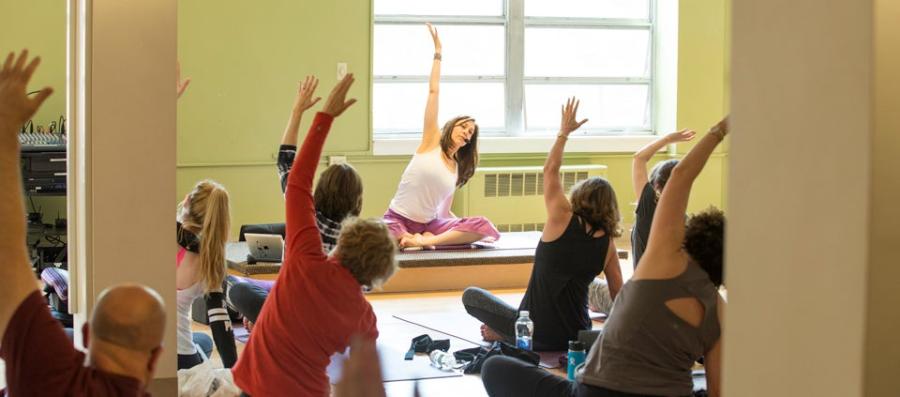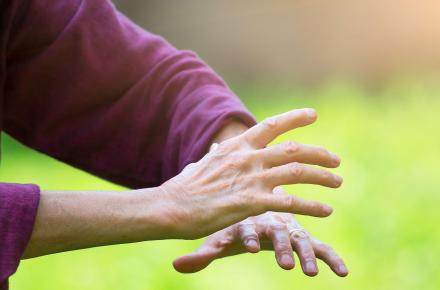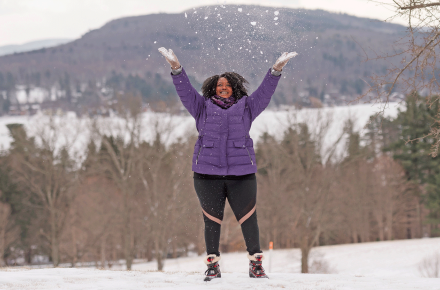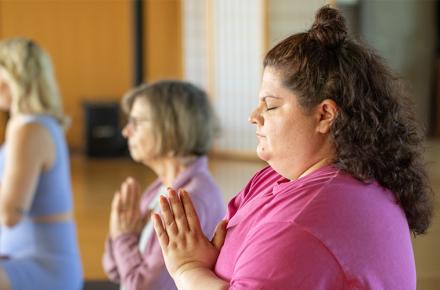On Being a ‘Fascia-nista’: A Q&A with Michelle Dalbec

Michelle Dalbec, a Lead Faculty member for the Kripalu School of Yoga, is fascinated with the human body in general and fascia in particular—she jokes that she’s “fascia-nista” (and yes, she owns a T-shirt that reads “Fascia is the new black”). In this Q&A, she explains how understanding the fascial system expands yoga teachers’ ability to support their students at all levels of experience.
Why is fascia only recently coming into yoga teachers’ awareness?
Scientists are just beginning to really understand the importance of fascia. Fifty or 100 years ago, surgeons would just take it out when they operated—they thought of it as basically packing peanuts for the body. There’s now a Fascial Congress, which recently had its sixth annual meeting—a team of doctors, anatomists, researchers, and movement specialists who work toward deeper understanding of the health properties of this tensile web in the body that keeps us functioning and mobile. They’re discovering that fascia has profound effects on our movement, proprioception, and self-healing capabilities.
What is fascia’s role in the body?
Fascia is everywhere. Every nerve is wrapped in fascia, every muscle fiber is wrapped in fascia, bundles of muscle fibers are wrapped in fascia and, when the muscles fibers stop, the fascia continues and surrounds the bone. It’s an interconnected matrix with different qualities in different areas of the body: some of it is fluffy and airy, almost slippery; some is thick and dense like a leather strap, such as the iliotibial band that connects the upper leg to the knee; some is like gauze or silk. Fascia holds a living history of the body on a cellular level: If you took out every bone and organ in your body, you would still have the shape and structure of the body, down to bones that have broken and healed.
When you move the body, there is a transmission of movement throughout its individual pieces and parts, and that transmission happens in large part through the fascia. If the fascia system is injured or bound up, that inhibits movement. It can affect an entire line of the body, because of the connectivity between the muscles and bones. Even postures that target one part of the body—like a backbend or a forward bend—will have a global effect on the whole body. A limited range of movement in the shoulder can affect the wrist, the hand, the fingers—there’s a cascading effect. Restrictions in the fascia system around the muscles of the chest and torso can restrict the breath and the practice of pranayama.
What does an understanding of the fascial system add to yoga teachers’ toolkits?
It’s imperative for yoga teachers today to have a foundational understanding of kinesiology and biomechanics. The more we understand this “energetic highway,” the more we can access another dimension or lens through which to assist our students to be more comfortable and supported in postures, and to understand their body better.
Say I’m teaching Warrior I, and a student is unable to fully engage the back leg. If I understand that it’s not necessarily about the knee or the quadriceps—it might be the abdominal muscles or the hips—then I can offer more effective modifications. I can also offer students a structural explanation of why they are unable to get into the full expression of a pose, which often empowers them to be more self-compassionate and more willing to practice a modified version. This understanding of the body, and the relationship of the poses to the body, is also helpful in supporting people who want to go to the next level in their process, and are asking their body to do deeper, more complex postures.
How does the health of our fascia affect our nervous system?
Because fascia is so rich with nerve receptors, relaxing the muscle tissue can actually down-regulate and de-stress the nervous system, specifically the vagus nerve. Stephen Porges coined the term “polyvagal theory,” which essentially says that we can impact the nervous system and the vagal response through the fascial network, when we work with it intelligently—through movement, touch, and self-massage, all of which help keep the fascia hydrated and healthy.
I am constantly amazed by the human body and all its layers—physical, energetic, emotional, intuitive—and by the profound and immediate effect the physical layer has on the subtle layers. Interoception, somatic meditation, all the mind-body connections that science is now looking at as revolutionary—yoga has been plugged into all of that for so long.


















































